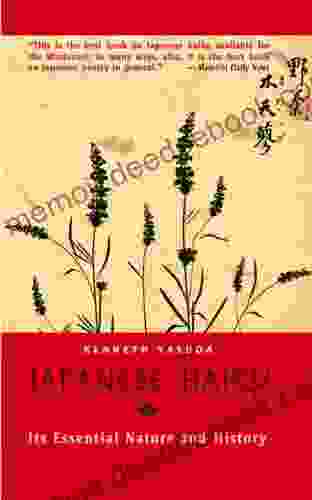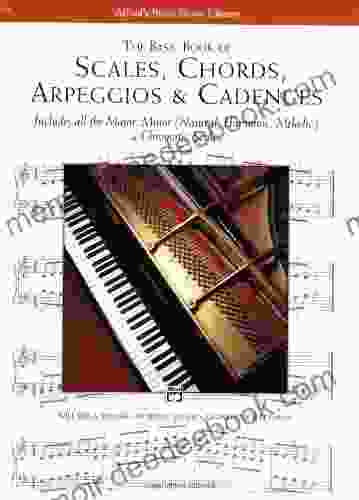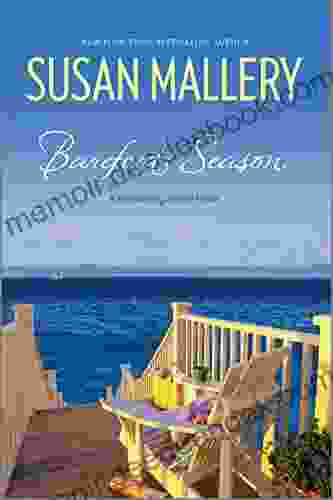Japanese Haiku: Exploring Its Essential Nature and Profound History

Haiku, a traditional form of Japanese poetry, has captivated readers for centuries with its ability to capture the beauty and impermanence of life in a few short lines. With its origins in ancient Japan, haiku has evolved over time to become a beloved art form, admired for its simplicity, depth, and evocative qualities. This article delves into the essential nature of haiku, exploring its structure, themes, and the influential masters who have shaped its evolution.
4.7 out of 5
| Language | : | English |
| File size | : | 989 KB |
| Text-to-Speech | : | Enabled |
| Screen Reader | : | Supported |
| Enhanced typesetting | : | Enabled |
| Word Wise | : | Enabled |
| Print length | : | 322 pages |
The Essential Nature of Haiku
Haiku is characterized by its brevity and adherence to a specific structure. It consists of three unrhymed lines, with five syllables in the first line, seven syllables in the second, and five syllables in the third. This 5-7-5 syllabic pattern provides a rhythmic cadence and a sense of balance to the poem.
Beyond its structure, haiku is renowned for its focus on nature and the seasons. It often captures a fleeting moment in time, describing a natural scene or event in a way that evokes a sense of wonder, awe, or peace. Haiku poets strive to capture the essence of a moment, often through the use of vivid imagery, sensory details, and unexpected juxtapositions.
The Emergence of Haiku
The roots of haiku can be traced back to the late Heian period (794-1185) in Japan. During this time, poets wrote short, untitled poems called waka, which often depicted nature scenes. In the 13th century, a new form of waka emerged, known as renga, which involved collaborative poetry writing. Renga consisted of linked verses, with each poet contributing a single stanza to the composition.
One of the most popular types of renga was the hokku, the opening stanza that set the tone and theme for the rest of the poem. Over time, hokku began to be written and appreciated as independent poems, eventually evolving into what we now know as haiku.
The Masters of Haiku
Throughout history, numerous haiku masters have emerged, leaving an indelible mark on the art form. Three of the most renowned masters are Matsuo Bashō, Kobayashi Issa, and Masaoka Shiki.
Matsuo Bashō (1644-1694): Bashō is widely considered the greatest haiku master of all time. His haiku are known for their vivid imagery, deep philosophical insights, and mastery of the 5-7-5 form. One of his most famous haiku is:
An old silent pond... A frog jumps into the pond, Splash! Silence again.
Kobayashi Issa (1763-1828): Issa was a contemporary of Bashō and is known for his unique style of haiku. His poems often explored themes of poverty, social injustice, and the beauty of everyday life. One of his most famous haiku is:
A world of dew, And within every dewdrop A world of struggle.
Masaoka Shiki (1867-1902): Shiki was a Meiji-era poet who is credited with modernizing haiku. He introduced new themes and techniques, such as the use of colloquial language and the depiction of contemporary urban life. One of his most famous haiku is:
On a withered branch A crow has settled – Autumn evening.
Modern Haiku
In the 20th and 21st centuries, haiku continued to evolve and spread beyond Japan. Western poets, inspired by the beauty and simplicity of haiku, began to write their own versions of the form. As a result, haiku is now practiced and enjoyed worldwide, with poets exploring diverse themes and styles.
Japanese haiku is a timeless art form that continues to captivate readers with its ability to capture the beauty, wonder, and impermanence of life. Through its concise form and evocative language, haiku offers a unique window into the human experience, inviting us to appreciate the beauty of nature, the passage of time, and the profound connections that exist in the world around us.
Whether you are a seasoned poetry enthusiast or new to the art of haiku, I encourage you to explore this extraordinary form of expression. Discover the works of the haiku masters and contemporary poets alike, and experience the timeless beauty and profound insights that haiku has to offer.
4.7 out of 5
| Language | : | English |
| File size | : | 989 KB |
| Text-to-Speech | : | Enabled |
| Screen Reader | : | Supported |
| Enhanced typesetting | : | Enabled |
| Word Wise | : | Enabled |
| Print length | : | 322 pages |
Do you want to contribute by writing guest posts on this blog?
Please contact us and send us a resume of previous articles that you have written.
 Book
Book Novel
Novel Page
Page Text
Text Genre
Genre Reader
Reader Library
Library Newspaper
Newspaper Paragraph
Paragraph Shelf
Shelf Glossary
Glossary Foreword
Foreword Preface
Preface Synopsis
Synopsis Annotation
Annotation Manuscript
Manuscript Scroll
Scroll Codex
Codex Bestseller
Bestseller Library card
Library card Biography
Biography Reference
Reference Encyclopedia
Encyclopedia Thesaurus
Thesaurus Narrator
Narrator Resolution
Resolution Librarian
Librarian Catalog
Catalog Card Catalog
Card Catalog Stacks
Stacks Periodicals
Periodicals Study
Study Scholarly
Scholarly Rare Books
Rare Books Special Collections
Special Collections Literacy
Literacy Dissertation
Dissertation Storytelling
Storytelling Awards
Awards Textbooks
Textbooks Rupert Smith
Rupert Smith John Kruth
John Kruth Christopher A Molnar
Christopher A Molnar Amit Agrawal
Amit Agrawal Peter Pomerantsev
Peter Pomerantsev Darrell P Hammer
Darrell P Hammer Beth Harry
Beth Harry J Bruce Jones
J Bruce Jones Lynne R Parenti
Lynne R Parenti Tori Chase
Tori Chase Alfred Fagon
Alfred Fagon Irina R Sucoverschi
Irina R Sucoverschi Payal Arora
Payal Arora Mary Ann Clark
Mary Ann Clark Jessica Trisko Darden
Jessica Trisko Darden Scott Rogers
Scott Rogers Ricky Schneider
Ricky Schneider Duncan Macvean
Duncan Macvean Juliet Foster
Juliet Foster Joseph P Ficalora
Joseph P Ficalora
Light bulbAdvertise smarter! Our strategic ad space ensures maximum exposure. Reserve your spot today!

 Walter SimmonsThe Adventures of Clim Joe, the Lost Bear: A Captivating Tale of Resilience...
Walter SimmonsThe Adventures of Clim Joe, the Lost Bear: A Captivating Tale of Resilience... Neil GaimanFollow ·12.9k
Neil GaimanFollow ·12.9k Ross NelsonFollow ·11.5k
Ross NelsonFollow ·11.5k Clarence MitchellFollow ·16.2k
Clarence MitchellFollow ·16.2k Ezekiel CoxFollow ·4.5k
Ezekiel CoxFollow ·4.5k Roger TurnerFollow ·6.3k
Roger TurnerFollow ·6.3k Greg CoxFollow ·17.2k
Greg CoxFollow ·17.2k Justin BellFollow ·6.8k
Justin BellFollow ·6.8k Aleksandr PushkinFollow ·10.9k
Aleksandr PushkinFollow ·10.9k

 Vernon Blair
Vernon BlairHow to Get a Woman to Pay for You: A Comprehensive Guide...
In the modern dating...

 Levi Powell
Levi PowellPrinciples and Theory for Data Mining and Machine...
Data mining and machine learning are two...
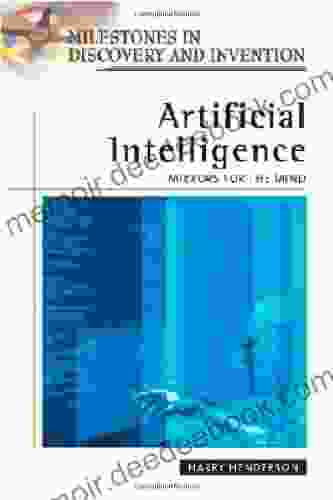
 Andrew Bell
Andrew BellMirrors For The Mind: Milestones In Discovery And...
Mirrors have been a part of human history...
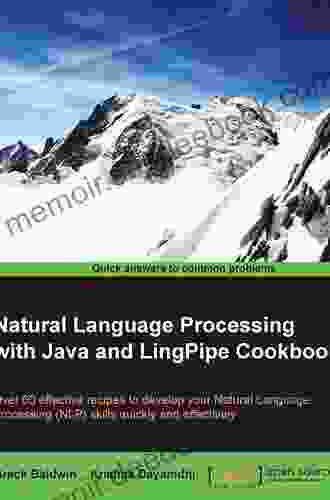
 Alec Hayes
Alec HayesDelving into Natural Language Processing with Java and...
Natural Language Processing (NLP) is an...
4.7 out of 5
| Language | : | English |
| File size | : | 989 KB |
| Text-to-Speech | : | Enabled |
| Screen Reader | : | Supported |
| Enhanced typesetting | : | Enabled |
| Word Wise | : | Enabled |
| Print length | : | 322 pages |


